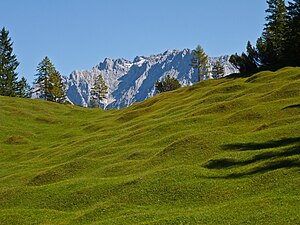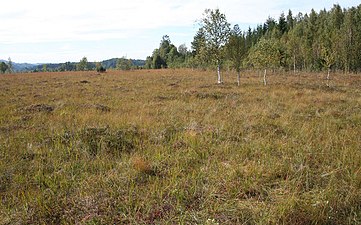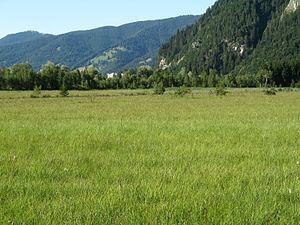Alpine and pre-Alpine meadows and moorlands
Alpine and pre-alpine meadows and moorlands is the title of a proposal from Germany for UNESCO World Heritage . The proposal includes historical cultural landscapes in the Werdenfelser Land , Ammergau , Staffelsee area and Murnauer Moos in the Garmisch-Partenkirchen district .
background
In the district of Garmisch-Partenkirchen have in particular the scope of the Alps and the Alpine foothills typical traditional forms of agriculture received.
World heritage proposal
At the suggestion of the Garmisch-Partenkirchen district, Bavaria submitted a serial application in 2012 from four cultural landscapes for inclusion in the tentative list for the UNESCO World Heritage under the title Alpine and pre-Alpine meadow and moorland landscapes (historical cultural landscapes in Werdenfelser Land, Ammergau, Staffelsee area and Murnauer Moos ) at the Standing Conference . An advisory board set up by the Conference of Ministers of Education recommended that the proposal be placed on the German tentative list. He also pointed out that the nomination area still had to be precisely defined and that the consent of the farmers involved had to be obtained. He also suggested a catchier title. In response to the resolution of the Conference of Ministers of Education and Cultural Affairs on June 12, 2014, the proposal was placed on the tentative list in January 2015 with an unchanged name (i.e. including the addition of brackets).
Among other things, the following is stated:
"The meadow landscapes in the Garmisch-Partenkirchen district are distinguished from other grassland areas on the northern edge of the Alps, which are equally attractive in terms of landscape, due to the still impressive and landscape-defining occurrence of traditionally cultivated meadows of high biodiversity ... The combination of traditionally and extensively used hay meadows in Slopes and valleys with the still very extensive use of litter meadows in the moors and floodplains of the Alpine valleys and the Alpine foothills. In addition, there is the close intermeshing of these "meadow moors" with unusually large, near-natural moor areas as well as a large supply of, so to speak, "fossil" cultural landscapes at all altitudes that still fulfill partial scenic and ecological functions ... "
The aim is to be entered in the World Heritage List based on criterion (v).
“(V): Comparable meadow landscapes can only be found in Europe and there in the humid subatlantic climate on the northern edge of the Alps. In many of their locations, these meadows have been degraded or partially urbanized due to increased land use. ... This internationally most comprehensive document for traditional meadow management in the German Alps shows the different degrees of utilization in a unique completeness and mutual dependency: "Wiesmahder" in distant, steep peripheral locations - blooming mountain meadows - hay meadow culture - communal meadows in moors and gravel pits in mountain rivers - extensive summer pastures at higher altitudes. ... The extensive use since the Subboreal (3700-1000 BC), which continues to this day, created very specific habitats with an exceptionally high biodiversity. The district of Garmisch-Partenkirchen has become a biodiversity hotspot in the entire Alps, not in spite of but because of the cultivating activities of mankind. "
scope
The proposal comprises the following individual sub-areas:
- Mountain meadows and humpback meadows in the Werdenfelser Land area ( location )
"The Mittenwald humpback meadows are classified in the justification for the World Heritage application as the most important humpback meadows across the Alps and possibly the world's most important."
- Wetlands in the Loisach Valley ( location )
"Along the Loisach, a coherent meadow landscape in the form of species-rich wet and litter meadows has been preserved over a length of approx. 20 km."
- Murnau moss and wetlands west of the Staffelsee ( location )
"Characteristic components of the traditional meadow landscapes in the Murnauer Moos and the wetlands west of the Staffelsee."
- Mountain meadows and moorland meadows in the Ammer Valley ( location )
"A special feature of the Upper Ammertal are the extensive Wiesmahd areas."
Web links
- Alpine and pre-Alpine meadows and moorlands on the website of the UNESCO World Heritage Center for tentative lists.
Individual evidence
- ↑ a b c Alpine and pre-alpine meadow and marsh landscapes (historic anthropogenic landscapes in the area of “Werdenfelser Land”, “Ammergau”, “Staffelseegebiet” and “Murnauer Moos”, Garmisch-Partenkirchen district). In: whc.unesco.org. UNESCO World Heritage Center, accessed January 28, 2018 .
- ↑ Final report . Recommendations of the Advisory Board to the Conference of Ministers of Education for updating the German tentative list for the UNESCO World Heritage. April 2014, p. 22 ( kmk.org [PDF]).
- ↑ Standing Conference of the Ministers of Culture of the Federal States in the Federal Republic of Germany: UNESCO - World Cultural Heritage: Update of the German List . Resolution of the Conference of Ministers of Education on June 12, 2014. ( kmk.org [PDF]).
- ↑ a b Significant cultural landscapes in the cultural landscape unit 55 Werdenfelser Land. In: www.lfu.bayern.de. Bavarian State Office for the Environment, accessed on June 22, 2018 .
- ↑ a b c Significant cultural landscapes in the cultural landscape unit 54 Pfaffenwinkel. In: www.lfu.bayern.de. Bavarian State Office for the Environment, accessed on June 22, 2018 .




